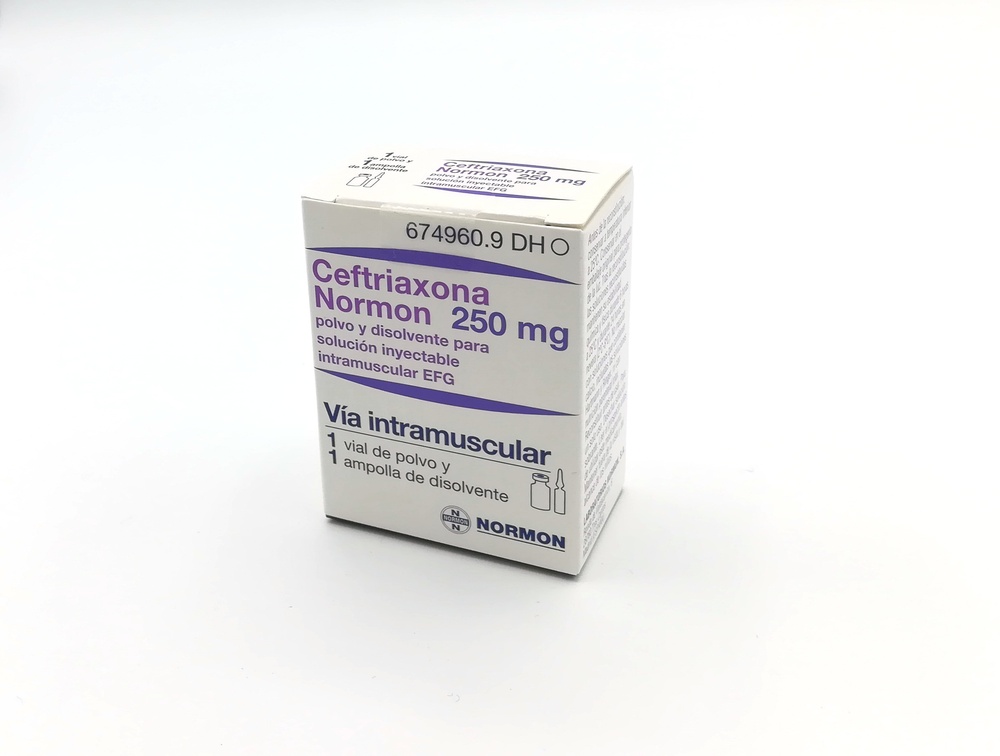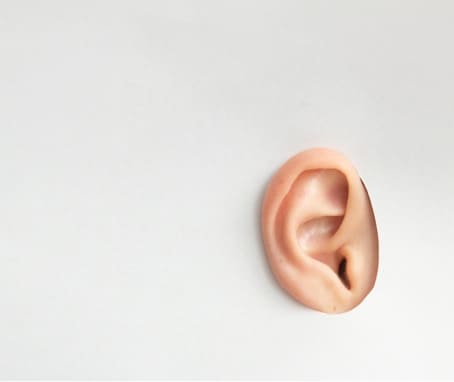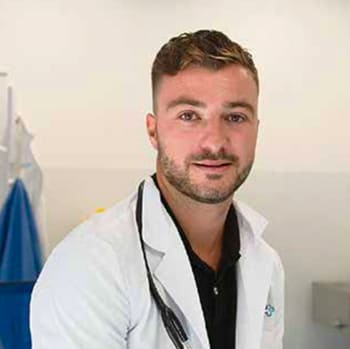

CEFTRIAXONA NORMON 250 mg PÓ E SOLUÇÃO PARA SOLUÇÃO INJETÁVEL INTRAMUSCULAR

Pergunte a um médico sobre a prescrição de CEFTRIAXONA NORMON 250 mg PÓ E SOLUÇÃO PARA SOLUÇÃO INJETÁVEL INTRAMUSCULAR

Como usar CEFTRIAXONA NORMON 250 mg PÓ E SOLUÇÃO PARA SOLUÇÃO INJETÁVEL INTRAMUSCULAR
Introdução
PROSPECTO: INFORMAÇÃO PARA O UTILIZADOR
Ceftriaxona Normon 250 mg pó e solução para solução injetável intramuscular EFG
Ceftriaxona
Leia todo o prospecto atentamente antes de começar a usar este medicamento, porque contém informações importantes para si.
- Conserva este prospecto, porque pode ter que voltar a lê-lo.
- Se tiver alguma dúvida, consulte o seu médico ou farmacêutico.
- Este medicamento foi-lhe prescrito para si e não deve dá-lo a outras pessoas, mesmo que tenham os mesmos sintomas, porque pode prejudicá-las.
- Se experimentar efeitos adversos, consulte o seu médico ou farmacêutico, mesmo que se trate de efeitos adversos que não aparecem neste prospecto. Ver secção 4.
Conteúdo do prospecto:
- O que é Ceftriaxona Normon e para que é utilizado.
- O que necessita de saber antes de começar a usar Ceftriaxona Normon
- Como usar Ceftriaxona Normon
- Efeitos adversos possíveis
- Conservação de Ceftriaxona Normon
- Conteúdo do envase e informações adicionais
1. O que é Ceftriaxona Normon e para que é utilizado
Este medicamento é um antibiótico que pertence ao grupo denominado cefalosporinas.
|
Ceftriaxona está indicado no tratamento de infecções graves, tais como:
- meningite bacteriana,
- infecções abdominais (como peritonite e infecções do trato biliar),
- infecções dos ossos e das articulações, infecções complicadas da pele e tecidos moles,
- infecções urinárias complicadas, incluindo pielonefrite (infecção no rim),
- infecções respiratórias,
- infecções genitais (incluindo doença gonocócica) e,
- as fases II e III da doença de Lyme (infecção causada pela picada de carrapato).
Ceftriaxona também está indicado para prevenir infecções antes ou depois de uma operação cirúrgica.
2. O que necessita de saber antes de começar a usar Ceftriaxona Normon
Não use Ceftriaxona Normon
- se é alérgico (hipersensível) ao princípio ativo ou às cefalosporinas, penicilinas ou qualquer outro antibiótico dos chamados β-lactâmicos ou a qualquer um dos outros componentes deste medicamento.
- em recém-nascidos com icterícia (coloração amarelada da pele por excesso de bilirrubina) ou hipoalbuminemia (déficit de uma proteína do sangue chamada albumina), nem em bebês prematuros devido ao risco de desenvolver encefalopatia hiperbilirrubinémica (uma doença que pode causar lesões cerebrais por acumulação de bilirrubina e ser mortal).
- ceftriaxona não deve ser misturado nem administrado simultaneamente com soluções ou produtos que contenham cálcio, mesmo que se utilize por vias de perfusão distintas, porque podem formar-se precipitados.
Advertências e precauções
Consulte o seu médico ou farmacêutico antes de começar a tomar Ceftriaxona Normon:
- Se teve alguma reação alérgica a ceftriaxona ou a qualquer penicilina ou sofreu alergias graves ou asma, porque ceftriaxona pode causar-lhe reações alérgicas que, por vezes, podem ser mortais (anafilaxia). Se isso lhe acontecer, contacte imediatamente um médico ou vá a um hospital mais próximo.
- Se apresenta uma diarreia intensa e duradoura durante ou após o uso deste medicamento, pode ser devido a um tipo de colite (colite pseudomembranosa) que pode ser grave. Neste caso, o seu médico suspenderá a administração de ceftriaxona e instituirá um tratamento adequado. Informe o seu médico se sofreu doenças gastrointestinais, particularmente colite.
- Se segue um tratamento prolongado com ceftriaxona, podem aparecer outras infecções (sobreinfecções) devidas a um sobre crescimento de alguns organismos, tais como enterococos ou cándidas.
- Quando segue tratamentos prolongados, o médico deve fazer-lhe análises de sangue periódicas.
- Se, devido à sedimentação de ceftriaxona cálcica, aparecem sinais e sintomas de doença da vesícula biliar, acompanhados de alterações nas ecografias da vesícula biliar. O risco destas alterações pode aumentar em tratamentos de mais de 14 dias, em pacientes com falha renal, desidratação ou nutrição parenteral total, bem como em crianças muito pequenas. Em caso de produzir-se, deve suspender-se a medicação com ceftriaxona.
- Antes de iniciar o tratamento com Ceftriaxona Normon, se sofre de doença grave do fígado ou do rim, porque pode necessitar de um ajuste da dose ou se tem risco de desenvolver pancreatite (inflamação do pâncreas).
- Se lhe vão realizar alguma prova diagnóstica (incluindo análises de sangue, urina, provas cutâneas que utilizam alérgenos, etc...) comunique ao médico que está usando este medicamento, porque pode alterar os resultados.
- Se experimenta ou experimentou uma combinação de qualquer um dos seguintes sintomas: erupção, vermelhidão da pele, bolhas nos lábios, os olhos e a boca, descamação da pele, febre alta, sintomas semelhantes aos da gripe, aumento dos níveis de enzimas hepáticos observados nos análises de sangue e um aumento num tipo de glóbulos brancos (eosinofilia) e aumento do tamanho dos gânglios linfáticos (sinais de reações cutâneas graves, consulte também a secção 4 “Efeitos adversos possíveis”).
- Se tem problemas hepáticos ou renais (ver secção 4).
Crianças e adolescentes
Crianças maiores de 12 anos, e com peso ≥50 kg, a mesma dose que adultos, ver mais adiante secção 3.
Crianças menores de 12 anos,
- Recém-nascidos (até 14 dias): 20 a 50 mg/kg de peso, administrados em uma única dose, sem que existam diferenças entre os nascidos a termo e os prematuros. Não se deve exceder a dose de 50 mg/kg de peso.
- Recém-nascidos (15-28 dias), lactentes (de 28 dias a 23 meses) e crianças (de 2 a 12 anos): dose única diária de 20-80 mg/kg de peso
Outros medicamentos e Ceftriaxona Normon
Informa ao seu médico ou farmacêutico se está utilizando ou utilizou recentemente outros medicamentos, mesmo os adquiridos sem receita.
O seu médico terá especial cuidado durante o uso simultâneo de ceftriaxona com:
- Probenecida (medicamento utilizado para tratar a gota)
- Outros antibióticos (medicamentos utilizados para as infecções).
- Anticoncepcionais hormonais. Recomenda-se adotar medidas adicionais durante o período de tratamento e no mês seguinte.
Gravidez e amamentação
Consulte o seu médico ou farmacêutico antes de utilizar qualquer medicamento.
Se está grávida ou acha que pode estar, informe o seu médico antes de usar este medicamento e ele decidirá a conveniência de o usar. O consumo de medicamentos durante a gravidez pode ser perigoso para o embrião ou o feto e deve ser vigiado pelo seu médico.
Condução e uso de máquinas
Não se demonstrou que o uso de Ceftriaxona Normon possa afetar a sua capacidade para conduzir veículos ou manejar ferramentas ou máquinas, mas há que ter em conta que ocasionalmente Ceftriaxona Normon pode produzir tonturas.
Ceftriaxona Normon contém sódio
Este medicamento contém menos de 23 mg de sódio (1mmol) por frasco; isto é, essencialmente “isento de sódio”.
Contém 0,45 mmol (10,405 mg) de sódio por ml de solução reconstituída.
3. Como usar Ceftriaxona Normon
Ceftriaxona é administrada por via intramuscular.
Para a administração intramuscular, deve dissolver o conteúdo do frasco em 2 ml de solvente da ampola que o acompanha.
Este medicamento deve ser administrado por um profissional de saúde.
Em caso de dúvida, consulte novamente o seu médico ou farmacêutico.
Dependendo da sua doença, idade, peso e da sua resposta ao tratamento com este medicamento, o seu médico prescrever-lhe-á a dose mais adequada e a duração do tratamento.
Nunca modifique a dose por sua conta. Se estima que a ação deste medicamento é demasiado forte ou fraca, comunique-o ao seu médico ou farmacêutico.
Continuará a receber este medicamento durante pelo menos 2 a 3 dias após ter-se recuperado da sua doença ou para prevenir infecções durante alguns dias após a sua operação cirúrgica.
Siga exatamente as instruções de administração do medicamento contidas neste prospecto ou as indicadas pelo seu médico ou farmacêutico. Em caso de dúvida, pergunte ao seu médico ou farmacêutico
Adultos, crianças maiores de 12 anos e de ≥ 50 kg: 1 a 2 g de ceftriaxona cada 24 horas, o que significa 1-2 g/ dia; em casos graves pode elevar-se a dose a 4 g/ dia.
Doença gonocócica (infecção genital não complicada):recomenda-se uma dose intramuscular única de 250 mg.
Fases II e III da doença de Lyme: recomenda-se administrar uma dose de 50 mg/kg de peso até um máximo de 2 gramas diários uma vez ao dia durante 14 dias.
Prevenção de doenças antes e depois de operações: de 1 a 2 g de ceftriaxona administrados 30- 90 minutos antes da intervenção.
Pacientes com alteração renal ou hepática: Em caso de pacientes com função renal alterada, não é preciso reduzir a dose de Ceftriaxona Normon, desde que a função hepática permaneça normal. Só em casos de depuração de creatinina < 10 ml/min., a dose de ceftriaxona não deve exceder os 2 g diários.
Pacientes em diálise: não é preciso uma dose adicional suplementar após a diálise, no entanto, serão monitorizadas as concentrações séricas para determinar se são necessários ajustes de dose, porque a taxa de eliminação nestes pacientes pode estar reduzida.
Pacientes de idade avançada: No caso de pacientes de idade avançada, não se requer modificar as doses recomendadas para adultos.
Crianças menores de 12 anos
Recém-nascidos (até 14 dias): 20 a 50 mg/kg de peso, administrados em uma única dose, sem que existam diferenças entre os nascidos a termo e os prematuros. Não se deve exceder a dose de 50 mg/kg de peso.
Recém-nascidos (15-28 dias), lactentes (de 28 dias a 23 meses) e crianças (de 2 a 12 anos): dose única diária de 20-80 mg/kg de peso.
Meningite bacteriana em recém-nascidos (15-28 dias), lactentes (de 28 dias a 23 meses) ecriançasde 2 a12 anos):iniciar tratamento com doses de 100 mg/kg (sem exceder os 4 g) uma vez ao dia. Assim que se identifique o germe causal e se determine a sua sensibilidade, pode ajustar-se consecutivamente a dose.
Em função da dosagem, existem outras apresentações mais adequadas para os diferentes regimes posológicos.
Se usa mais Ceftriaxona Normon do que deve
Em caso de sobredose por esta via de administração, pode dar origem a convulsões e alterações gastrointestinais.
Em caso de sobredose, ou ingestão acidental, consulte imediatamente o seu médico ou farmacêutico ou ligue para o Serviço de Informação Toxicológica, telefone 91 562 04 20, indicando o medicamento e a quantidade utilizada.
Informação para o profissional de saúde
Interrompa imediatamente o tratamento com ceftriaxona e devem ser instituídas as medidas terapêuticas e de suporte adequadas.
Não existe antídoto específico. Não se elimina por diálise.
Se esqueceu de usar Ceftriaxona Normon
Não use uma dose dupla para compensar as doses esquecidas.
Se interrompeu o tratamento com Ceftriaxona Normon
Não suspenda o tratamento antes de terminá-lo, porque não logrará o efeito desejado. É muito importante tratar as infecções durante o tempo recomendado, caso contrário, poderá piorar.
Se tiver alguma dúvida sobre o uso deste produto, pergunte ao seu médico ou farmacêutico.
4. Efeitos adversos possíveis
Ceftriaxona não deve ser misturado nem administrado simultaneamente com soluções ou produtos que contenham cálcio, mesmo que se utilize por vias de perfusão distintas.
Foram descritos casos de reações que provocaram a morte de recém-nascidos e crianças prematuras pela formação de precipitados da sal cálcica de ceftriaxona nos pulmões e nos rins destes pacientes. Em alguns casos, as vias de perfusão e os tempos de administração de ceftriaxona e das soluções que contêm cálcio foram diferentes.
Assim como todos os medicamentos, Ceftriaxona pode ter efeitos adversos, embora nem todas as pessoas os sofram.
Efeitos adversos frequentes (podem afetar até 1 de 10 pessoas):
Diarreias, náuseas, estomatite (inflamação da mucosa da boca) e glosite (inflamação da língua).
Efeitos adversos pouco frequentes (podem afetar até 1 de 100 pessoas):
Exantema (erupção cutânea), dermatite alérgica (inflamação da pele), rash (exantema), edema (acumulação de líquido nos tecidos) e eritema multiforme.
Efeitos adversos raros (podem afetar até 1 de 1.000 pessoas):
Vulvovaginite (infecções do trato genital feminino causadas por bactérias), anemia (diminuição da concentração de hemoglobina no sangue) leucopenia (diminuição do número de leucócitos no sangue), granulocitopenia (diminuição da cifra de granulócitos no sangue), trombocitopenia (diminuição do número de plaquetas no sangue), eosinofilia (aumento de um determinado grupo de glóbulos brancos), reações anafilácticas (alérgicas) ou anafilactoides, urticária (prurido generalizado na pele), cefaleia (dor de cabeça), tonturas, precipitação sintomática de ceftriaxona cálcica na vesícula biliar e aumento dos enzimas hepáticos (parâmetros que se detectam nos análises de sangue), oligúria (diminuição da produção de urina), aumento da creatinina sérica (parâmetro que se detecta nos análises de sangue), febre, arrepios e flebite (inflamação das veias) que pode ser ainda menos frequente se se aplicar mediante uma injeção lenta durante um período de 2-4 minutos).
Efeitos adversos muito raros (podem afetar até 1 de 10.000 pessoas):
Distúrbios da coagulação, agranulocitose (diminuição ou ausência de glóbulos brancos no sangue) sobretudo após 10 dias de tratamento ou após doses elevadas, colite pseudomembranosa (diarreias agudas e graves causadas por uma sobreinfecção por uma bactéria), pancreatite, hemorragia gastrointestinal, síndrome de Stevens-Johnson, necrólise epidérmica tóxica ou síndrome de Lyell (destruição da pele com desprendimento epitelial que se inicia com a formação de bolhas, mas sem inflamação), precipitação renal de ceftriaxona sódica em pacientes pediátricos, hematúria (presença de sangue na urina).
Efeitos adversos de frequência não conhecida (a frequência não pode ser estimada a partir dos dados disponíveis)
Reações cutâneas graves. Se tem como reaçãouma erupção cutânea grave, informe um médico imediatamente.
Os sintomas podem incluir:
- uma erupção grave que se desenvolve rapidamente, com bolhas ou descamação da pele e possivelmente bolhas na boca (síndrome de Stevens-Johnson e necrólise epidérmica tóxica, também conhecidas como SSJ e NET).
- Uma combinação de qualquer um dos seguintes sintomas: erupção cutânea generalizada, temperatura corporal alta, elevação dos valores das enzimas hepáticas, anomalias no sangue (eosinofilia), aumento do tamanho dos gânglios linfáticos e afetação de outros órgãos do corpo (reação a fármaco com eosinofilia e sintomas sistémicos, também conhecida como DRESS ou síndrome de hipersensibilidade a medicamentos).
- Reação de Jarisch-Herxheimer que produz febre, arrepios, dor de cabeça, dor muscular e erupção cutânea que geralmente é autolimitada. Isso ocorre pouco após começar o tratamento com ceftriaxona para infecções com espiroquetas, como a doença de Lyme.
O tratamento com ceftriaxona, em particular em pacientes de idade avançada com problemas graves de rim ou com problemas do sistema nervoso, raramente pode causar diminuição da consciência, movimentos anormais, agitação e convulsões.
Problemas com a vesícula biliar ou o fígado, que podem causar dor, náuseas, vómitos, coloração amarelada da pele, prurido, urina anormalmente escura e fezes de cor de argila.
Comunicação de efeitos adversos
Se experimenta qualquer tipo de efeito adverso, consulte o seu médico, farmacêutico ou enfermeiro, mesmo que se trate de possíveis efeitos adversos que não aparecem neste prospecto. Também pode comunicá-los diretamente através do Sistema Espanhol de Farmacovigilância de Medicamentos de Uso Humano (Website: www.notificaRAM.es)
Ao comunicar efeitos adversos, você pode contribuir para fornecer mais informações sobre a segurança deste medicamento.
5. Conservação de Ceftriaxona Normon
Mantenha fora do alcance e da vista das crianças.
Conservar a temperatura inferior a 25ºC. Conservar no embalagem original para proteger do luz.
Antes da reconstituição: Não utilize Ceftriaxona Normon após a data de validade que aparece no invólucro após “CAD”. A data de validade é o último dia do mês que se indica.
Após a reconstituição: As soluções reconstituídas mantêm a estabilidade química e física durante 6 horas a 25 ºC e durante 24 horas na geladeira (2ºC-8 ºC).
Desde um ponto de vista microbiológico, o produto deve ser utilizado imediatamente. Se não for utilizado imediatamente, as condições de conservação e o tempo, antes do uso, são responsabilidade do profissional, não devendo superar as 24 horas conservado entre 2 e 8ºC, a menos que a reconstituição tenha ocorrido em condições assépticas controladas e validadas.
Os medicamentos não devem ser jogados nos esgotos nem na lixeira. Deposite os invólucros e os medicamentos que não precisa no Ponto SIGRE da farmácia. Em caso de dúvida, pergunte ao seu farmacêutico como se livrar dos invólucros e dos medicamentos que já não precisa. Dessa forma, ajudará a proteger o meio ambiente.
6. Conteúdo do envase e informação adicional
Composição de Ceftriaxona Normon
O princípio ativo é ceftriaxona (como ceftriaxona sódica). Cada frasco de pó contém 250 mg de ceftriaxona (como ceftriaxona sódica).
A ampola de solvente contém 20 mg de hidrocloruro de lidocaína monohidratado.
Uma vez reconstituído com os 2 ml de solvente com hidrocloruro de lidocaína monohidratado contidos na ampola, a concentração da solução é 125 mg de ceftriaxona (como ceftriaxona sódica) por ml
Os demais componentes (excipientes) são:
Ampola de solvente: água para preparações injetáveis.
Aspecto do produto e conteúdo do envase
Apresenta-se em frasco de vidro, fechado com um tampão de borracha e selado com uma cápsula flip-off, e 1 ampola de solvente.
Embalações de 1 frasco
Pode ser que apenas alguns tamanhos de embalagens sejam comercializados.
Título da autorização de comercialização e responsável pela fabricação
LABORATÓRIOS NORMON, S.A.
Ronda de Valdecarrizo, 6 – 28760
Tres Cantos – Madrid (ESPANHA)
Este prospecto foi revisado em:Dezembro 2023
A informação detalhada e atualizada deste medicamento está disponível na página Web da Agência Espanhola de Medicamentos e Produtos Sanitários (AEMPS) http://www.aemps.gob
---------------------------------------------------------------------------------------------------------------
Esta informação está destinada unicamente a profissionais do setor sanitário
Este medicamento é reconstituído antes do seu uso. A solução reconstituída é para um único uso. Descartar a solução sobrante.
A solução reconstituída é límpida e amarela ou ligeiramente amarelenta.
Incompatibilidades
As soluções que contenham ceftriaxona não devem ser misturadas nem devem ser adicionados outros agentes. Em particular, os diluentes que contenham cálcio (Por Ex., solução Ringer, solução Hartmann) não devem ser usados para reconstituir os frascos de ceftriaxona nem para diluir os frascos reconstituídos quando for administrado por via IV, pois pode formar precipitados. A ceftriaxona não deve ser misturada nem administrada simultaneamente com soluções que contenham cálcio
Ceftriaxona é incompatível com amsacrina, vancomicina, fluconazol e aminoglicosídeos
Forma de administração
Apenas para via intramuscular.
Para a administração intramuscular, dissolve-se o conteúdo do frasco em 2 ml de solvente da ampola que o acompanha (uma solução de hidrocloruro de lidocaína monohidratado 20 mg/2 ml).
Uma vez reconstituído com os 2 ml de solvente, a concentração da solução é de 125 mg de ceftriaxona (como ceftriaxona sódica) por ml.
Deve examinar-se a solução antes de injetá-la por si apresentar partículas ou turbidez. Se se observam partículas estranhas, descartar a solução. Seguidamente, injetar em um músculo relativamente grande. Não colocar mais de 1 grama no mesmo local. Para doses superiores a 2 g, deve-se utilizar a administração intravenosa.
A dose e a pauta de administração utilizada são em função da idade e peso do paciente, bem como da gravidade da infecção.
A solução não deve ser misturada com soluções contendo outros antibióticos ou em outras soluções diferentes das acima assinaladas.
- País de registo
- Substância ativa
- Requer receita médicaSim
- Fabricante
- Esta informação é apenas para referência e não constitui aconselhamento médico. Consulte sempre um médico antes de tomar qualquer medicamento. A Oladoctor não se responsabiliza por decisões médicas baseadas neste conteúdo.
- Alternativas a CEFTRIAXONA NORMON 250 mg PÓ E SOLUÇÃO PARA SOLUÇÃO INJETÁVEL INTRAMUSCULARForma farmacêutica: INJETÁVEL, 1 g de ceftriaxona dissódicaSubstância ativa: ceftriaxoneFabricante: Fresenius Kabi España, S.A.U.Requer receita médicaForma farmacêutica: INJETÁVEL, 1 g de ceftriaxona dissódicaSubstância ativa: ceftriaxoneFabricante: Fresenius Kabi España, S.A.U.Requer receita médicaForma farmacêutica: PERFURAÇÃO INJETÁVEL, 2 g de ceftriaxona dissódicaSubstância ativa: ceftriaxoneFabricante: Fresenius Kabi España, S.A.U.Requer receita médica
Alternativas a CEFTRIAXONA NORMON 250 mg PÓ E SOLUÇÃO PARA SOLUÇÃO INJETÁVEL INTRAMUSCULAR noutros países
As melhores alternativas com o mesmo princípio ativo e efeito terapêutico.
Alternativa a CEFTRIAXONA NORMON 250 mg PÓ E SOLUÇÃO PARA SOLUÇÃO INJETÁVEL INTRAMUSCULAR em Polónia
Alternativa a CEFTRIAXONA NORMON 250 mg PÓ E SOLUÇÃO PARA SOLUÇÃO INJETÁVEL INTRAMUSCULAR em Ukraine
Médicos online para CEFTRIAXONA NORMON 250 mg PÓ E SOLUÇÃO PARA SOLUÇÃO INJETÁVEL INTRAMUSCULAR
Avaliação de posologia, efeitos secundários, interações, contraindicações e renovação da receita de CEFTRIAXONA NORMON 250 mg PÓ E SOLUÇÃO PARA SOLUÇÃO INJETÁVEL INTRAMUSCULAR – sujeita a avaliação médica e regras locais.















